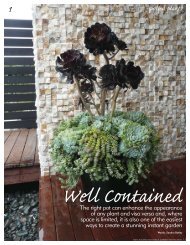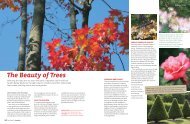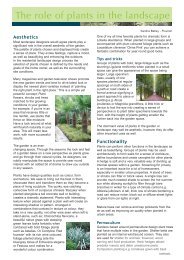winter gardens
winter gardens
winter gardens
You also want an ePaper? Increase the reach of your titles
YUMPU automatically turns print PDFs into web optimized ePapers that Google loves.
<strong>winter</strong> <strong>gardens</strong><br />
Winter for most of us is a time for staying indoors<br />
relishing the warmth of open fires and hot food. As the<br />
temperature drops, so does the desire to be outdoors<br />
in the garden…. But a garden in <strong>winter</strong> does not need<br />
to be dreary and bare. Although a <strong>winter</strong> garden lacks<br />
the joy of flowers that spring can bring and the lush<br />
abundance of summer time foliage, there is still a wide<br />
choice of flowering trees, shrubs and <strong>winter</strong> annuals to<br />
bring some life into your garden. With some careful<br />
planning it is possible to create a <strong>winter</strong> garden that<br />
provides colour and interest during the cold season.<br />
Planning<br />
While inside on those cold rainy days, when the long<br />
hazy days of summer seem like a million miles away,<br />
start dreaming and planning how you want your garden<br />
to look not just in summer but all year round. Whether<br />
you have an existing garden that needs a renovation or<br />
you have new site that requires a new design from<br />
scratch, start putting some ideas down on paper or<br />
commission a professional landscape designer to<br />
create some plans for you. After the plan is complete, a<br />
lot of the structure and layout of the garden can be built<br />
in <strong>winter</strong> and planting can begin from autumn to early<br />
spring, then sit back and reap the rewards.<br />
Creating <strong>winter</strong> colour<br />
For a quick fix, add instant colour in the garden where<br />
summer perennials have gone dormant or where there<br />
are some bare spaces around trees or shrubs. If you<br />
written by Sandra Batley - Flourish<br />
like flowers, then <strong>winter</strong> annuals such as Polyanthus,<br />
Primula’s and Pansies give the garden an instant lift.<br />
Pansies come in all colours and sizes of flowers, so<br />
you can plan your <strong>winter</strong> colour schemes. For a quick<br />
fix, create a colourful entrance area using Polyanthus<br />
or try white Primula’s with their dainty open flowers.<br />
They look stunning en masse during <strong>winter</strong>. Plant in<br />
large drifts under trees or as a soft filler behind crisp<br />
clipped formal hedging or plant in large containers for<br />
courtyards and decks. Winter annuals should be<br />
planted in March and April, while the soil is still warm. If<br />
foliage is your thing then choose from a wide range of<br />
native coloured flaxes or divaricating shrubs.<br />
The beauty of trees and shrubs<br />
Trees and shrubs add year round beauty and structure<br />
to the garden. For best results trees are best planted<br />
during the months of April through to<br />
September/October. This gives roots a chance to get<br />
established before the stress of long hot summer days<br />
set in. Deciduous trees give shade in the summer and<br />
lets in valuable sun during <strong>winter</strong>. Cool crisp days<br />
where the delicate bare skeletal form of a tree creates<br />
an amazing silhouette against the clear blue sky. The<br />
bark of a tree can also create some excitement in a<br />
<strong>winter</strong> garden. Try planting trees such as the Paperbark<br />
Maple or a Birch tree with bark that peels to produce a<br />
colorful display on their trucks. Evergreen trees add<br />
texture with their variation of leaf shapes and<br />
interesting forms. Early blooming Magnolia denuata<br />
continued...
and M. Stella provides valuable additional colour in the<br />
late <strong>winter</strong>. The <strong>winter</strong> flowering cherry Prunus<br />
subhirtalla autumnalis ‘Rosea’ has delicate shell pink<br />
blooms. This beautiful small tree puts on a gorgeous<br />
display and is particularly suited to woodland areas.<br />
Some on our own New Zealand natives provide colour<br />
during the dullest <strong>winter</strong> months. Leptospernum<br />
varieties put on a colourful display with red, pink or<br />
white flowers. Kowhai Sophora ‘Dragons Gold’ or ‘Early<br />
Gold’ has delicate gold/yellow flowers. Hebe ‘Wiri Mist’<br />
has a flush of magenta colored flowers in early <strong>winter</strong><br />
and H. ‘Lavender Lace’ has mauve-white flowers.<br />
Banksias are an Australian native, the <strong>winter</strong> flowering<br />
varieties have flowers which nectar feeding birds such<br />
as Tuis love to feed from. Proteas and Leucadendrons<br />
from Africa put on a bold display through <strong>winter</strong> and<br />
spring and also make wonderful cut flower displays for<br />
inside the home.<br />
If you live in warmer parts of the country then you can’t<br />
go past planting Michela doltsopa or Gordonia axillaris,<br />
both have lovely white flowers. M. Doltsopa has a fruity<br />
lemony fragrance.<br />
Tropical and succulent plants<br />
In the north where <strong>winter</strong>s are milder, there are a range<br />
of subtropical plants and succulents that give the<br />
garden plenty of colour in <strong>winter</strong>. Aloe thraskii produces<br />
stunning yellow flowers and Aloe arborescens has vivid<br />
orange flowers. Another plant to try is Bromeliads. They<br />
come in a variety of colours with stripes or spots and<br />
can grow in a variety of conditions from deep shade to<br />
full sun. Tibouchina urvilleana ‘Edwardsii’ it is an easy<br />
care shrub that has vivid purple flowers. Abutilons are<br />
another versatile shrub that produces red or yellow<br />
<strong>winter</strong> flowers.<br />
Old time classics<br />
And finally you just can’t beat old-time classic<br />
favourites such as Camellias, Azaleas,<br />
Rhododendrons, Daphne and Hellebores (Winter rose)<br />
and Lavendula dentate (lavender). These plants<br />
provide colour and fragrance in a <strong>winter</strong> garden.<br />
Camellia sasanquas are suitable for espalier and<br />
hedging. Camellia japonicas are perfect for open,<br />
larger <strong>gardens</strong>. They come in various shades of pink,<br />
white and red. Daphne has a perfume that will fill and<br />
sweeten the chilly air, so plant near the entrance or an<br />
outdoor seating area. Hellebores are an evergreen<br />
perennial that looks great massed underneath trees.<br />
They also do well out in the full sun and will produce a<br />
wonderful display of flowers.<br />
Plants offer a unique beauty within the <strong>winter</strong> garden.<br />
Adding garden accessories such as benches, arborsz,<br />
water features, garden sculptures and statues will<br />
further create lasting permanent points of interest.

















